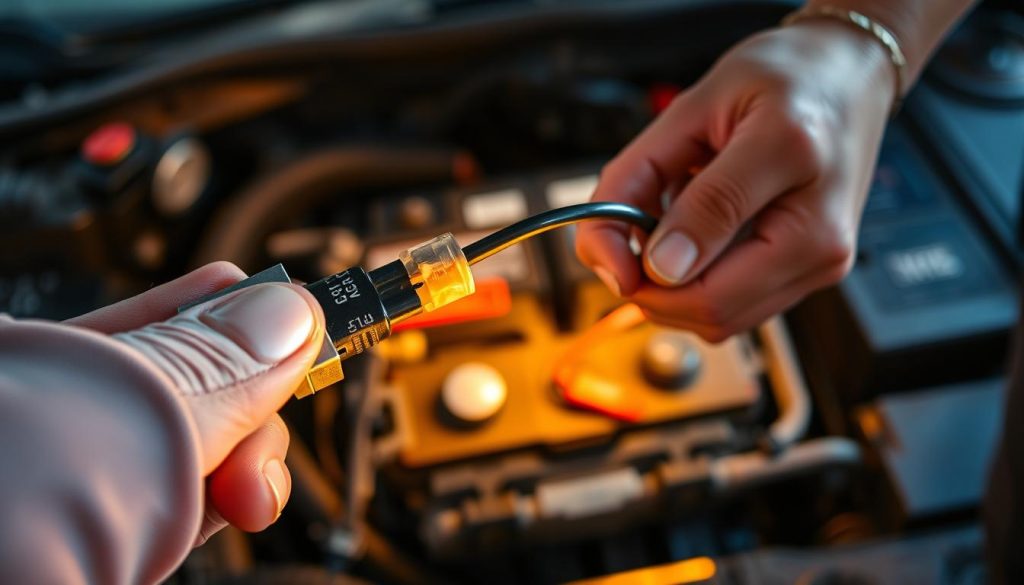Battery cables are vital for your car’s electrical system. They link the battery to key systems like starting and charging. Knowing how to change them can prevent electrical issues and keep your car running well.
Corrosion can hurt battery performance. It increases resistance and reduces electrical flow. When cables get worn or corroded, they need to be replaced1.
Changing battery cables might seem tough, but it’s actually quite simple. It’s a beginner-friendly task that many car owners can do themselves2.
Key Takeaways
- Battery cables are critical for vehicle electrical systems
- Corrosion can cause significant electrical performance issues
- DIY car battery cable replacement is possible for beginners
- Regular maintenance prevents potential electrical failures
- Proper tools and safety precautions are essential
Safety Precautions and Required Tools for Battery Cable Replacement
DIY car repair needs careful prep when working with vehicle batteries. Understanding key steps for jumper cable care prevents accidents. This ensures a successful replacement process3.
Essential Safety Gear
Your safety comes first during battery work. Proper equipment stops potential injuries.
- Safety glasses to shield eyes from battery acid splashes3
- Protective gloves to reduce skin exposure risks3
- Clothing that covers exposed skin
- Workspace with proper ventilation to minimize harmful fume inhalation3
Pre-Replacement Inspection
Before fixing battery terminal corrosion, do a thorough check:
- Check battery terminals for visible corrosion signs4
- Examine cables for wear and damage
- Verify battery age and condition4
- Measure battery voltage (ideal reading: 12.6V)5
Good prep stops 30% of battery-related problems. Keep a fire extinguisher nearby for safety.
Work in a well-lit area to lower risks3.
Essential Tools for the Job
Get these tools before starting your battery cable replacement:
- Socket wrench (10mm-13mm)4
- Battery terminal puller
- Wire brush
- Anti-corrosion washers3
- Corrosion-resistant gel3
Safety tip: If battery acid contacts skin, flush immediately with water and seek medical attention5.
Follow these safety steps and prep well. You’ll be ready to change your battery cable with confidence5.
How to Change Battery Cables Step by Step
Replacing battery cables needs careful attention. These parts connect your battery to vital vehicle systems. Proper replacement can prevent electrical issues and save time.
- Battery terminal cleaning tool
- Diagonal cutters
- Replacement battery cables
- Wrench set
- Protective gloves
Start by disconnecting the battery cables. Always remove the negative (black) terminal first to prevent electrical shorts. The negative cable is usually black with a minus sign.
It’s often bolted to the engine frame. Check the cables for major corrosion. Bad cables can cause starting problems.
If you need new cables, make sure they match in length and terminal ends.
Follow these steps to install new cables:
- Clean battery terminals thoroughly
- Attach the positive (red) cable to the starter
- Connect the negative (black) cable to the engine block
- Ensure secure, tight connections
Reconnect the battery with care. Start with the positive terminal, then the negative. Test the connections to make sure they’re installed correctly.
Conclusion
Mastering battery cable replacement is crucial for vehicle troubleshooting. It saves time and money while preventing unexpected breakdowns. Regular inspections help identify issues early, with replacements recommended every 50,000 to 100,000 km6.
Choosing the right battery cable is important. Different wire gauges suit various needs, from low-power alternators to high-performance engines7. SGT battery cables offer cost-effective solutions for most automotive needs. They withstand temperatures up to 80°C and meet industry standards7.
DIY replacement techniques can halve maintenance costs6. A quality battery cable maintenance guide boosts confidence in tackling electrical system issues. However, professional evaluations are still important for deeper problems like corrosion6.
Understanding your vehicle’s electrical system improves reliability and performance. With knowledge, proper tools, and a systematic approach, vehicle troubleshooting becomes less daunting. Your commitment to maintenance will pay off in the long run.
FAQ
How often should I replace my car’s battery cables?
Can I replace battery cables myself, or should I go to a professional?
What tools do I need to change battery cables?
How do I know if my battery cables need replacement?
What’s the correct sequence for disconnecting and reconnecting battery cables?
How long does it take to change battery cables?
What type of battery cables should I buy?
How can I prevent battery cable corrosion?
Source Links
- How to Change Battery Cables | YourMechanic Advice – https://www.yourmechanic.com/article/how-to-change-battery-cables-by-ed-ruelas
- How To Replace the Battery Terminals in Your Car – https://www.familyhandyman.com/project/how-to-replace-the-battery-terminals-in-your-car/?srsltid=AfmBOooCdOqU-TYmpiW7GXgZ2jVHS_vcP2kLJeISmLk0lsRhotFK-OP4
- DIY: Tools You Need to Change a Car Battery Safely – Dave’s Valley Auto Clinic – https://www.davesvalleyautoclinic.com/tools-needed-to-change-car-battery-safely/
- How to Change a Car Battery – https://www.homedepot.com/c/ah/how-to-change-a-car-battery/9ba683603be9fa5395fab9090232265
- How To Replace the Battery Terminals in Your Car – https://www.familyhandyman.com/project/how-to-replace-the-battery-terminals-in-your-car/?srsltid=AfmBOoqE3m6mBP7JsYm5yZAedIFjQ0uDeFC45MhUSRvjr3aM7KnOa_cb
- Battery Cable Lifespan: How Long Does It Last? – Uchanics: Auto Repair – https://uchanics.ca/battery-cable-lifespan-how-long-does-it-last/
- Battery Cable Assembly: An Ultimate Guide on Battery Cables – https://www.linkedin.com/pulse/battery-cable-assembly-ultimate-guide-cables-lillian-yang-uw0oc
